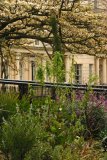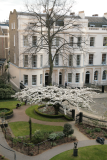Additional notes (click to expand)
Horticulture
The last one at the Chelsea Physic garden was grubbed up to make an air raid shelter during World War II, but before it vanished, cuttings were taken. The resulting clones are the ‘Dolly the sheep’ trees, with genes that have been growing and dividing, producing leaves, flowers and fruit for 400 years. The tree with which we were presented is a cutting from one of the trees produced from these cuttings, or even a cutting from a cutting (etc., etc.) for the past 70 years. It was planted with much ceremony by the Treasurer and President in mid-June 2011. The genome of our new tree was present in a sapling when the College published its Pharmacopoeia Londinensis in 1618, it may even be still controlling growth and fruiting when the branches are gnarled and heavy and the College celebrates its 800th anniversary. The saplings brought in by King James might have even been produced from cuttings taken from another ancient tree that saw life begin in the 13th century (and so on to the beginning of time, or at least to when it first grew in Persia before being spread across the world). In Persia this mulberry would not be a toot (an ordinary one) but a shahtoot, the name for a king’s mulberry, for ours is a precious and valued clone with bigger and sweeter fruits.
It is a good plant for our medicinal garden, the vitamin C in its fruit (gardeners’ perks) is essential for life, and it is resistant to diseases like honey fungus. It reminds us of King James who liberated the Apothecaries from the Bakers Company, of Martin Lister and other Fellows of the College who tended the King’s health, and takes us back to the time when red fruits were associated with the red, hot, humours so were used as medication to treat the common cold, due – as you will remember – to an excess of the cold phlegmatic humour. The juice even has anti-hyperglycaemic activity – at least in diabetic rats. Above all we can wonder at the ability of a plant to have the potential for eternal life and perpetual rejuvenation for endless youth.
Oakeley, H. Sept 2011 internal note
Sometime around 1935 a beautiful Japanese cherry tree, Prunus serrulata var. longipes ‘Shogetsu’, was planted in the garden at the end of St Andrews Place. This was thirty years before the College moved to our present site, and another five years before we took over this garden. For decades it covered its outstretched branches with double pink-white blooms in April until age began to tell, the canopy began to thin, and a fatal infection with honey fungus, Armillaria, was diagnosed. In the spring of 2011 it was regarded as being potentially unsafe and was removed, with much sadness in the College. Bare space remained, but a chance encounter at a book launch, resulted in Jack Peppiatt and Amanda Peters donating a mulberry tree to the College. Not an ordinary mulberry, but Morus nigra ‘King James’, named for King James 1 of England whose authorised version of the Bible was published 400 years ago in 1611. King James was an active monarch, and a friend of the College. He published A Counterblaste to Tobacco in 1604 attacking the smoking habit (it took the College another 350 years before it produced anything similar). He decided that England should become self-sufficient in silk so, in 1608-9 he imported tens of thousands of mulberry trees, for silkworm caterpillars feed on them. Seven hundred were planted on the land where Buckingham Palace was later built, and Chelsea Physic garden planted several. The discovery that he had imported the wrong one, because silkworms prefer Morus alba must have been a trifle embarrassing, but the trees prospered, the fruit was delicious, and a few are still alive today.
Oakeley, H. Sept 2011 internal note
Nomenclature
It is a grafted clone from a plant which was awarded an Award of Merit in 1930, and the Award of Garden Merit in 1933 by the Royal Horticultural Society.
Syn. = serrulata var. longipes'; 'Shimizu-zakura' ; 'Blushing Bride' ; serrulata 'Miyako'; 'Okumiyako'; 'Blushing Bride'.
The Royal Horticultural Society Horticultural Database, available at www.rhs.org.uk
Toxicity
Prunus ... contain under their bark cyanogenetic glycosides which serve the additional function of deterring rabbits or deer from gnawing them in winter.
Ball, P A J . (1981). Plants, their predators and the physician. Journal of the Royal College of Physicians, London.
Prunus serrulata var. longipes 'Shogetsu'
Family: ROSACEAEGenus: Prunus
Species: serrulata
Variety: longipes
Cultivar: 'Shogetsu'
Common names: Cherry 'Shogetsu'
Habit: Tree
Hardiness: H5 - Hardy; cold winter
Garden status: Not currently grown
.jpg)










































